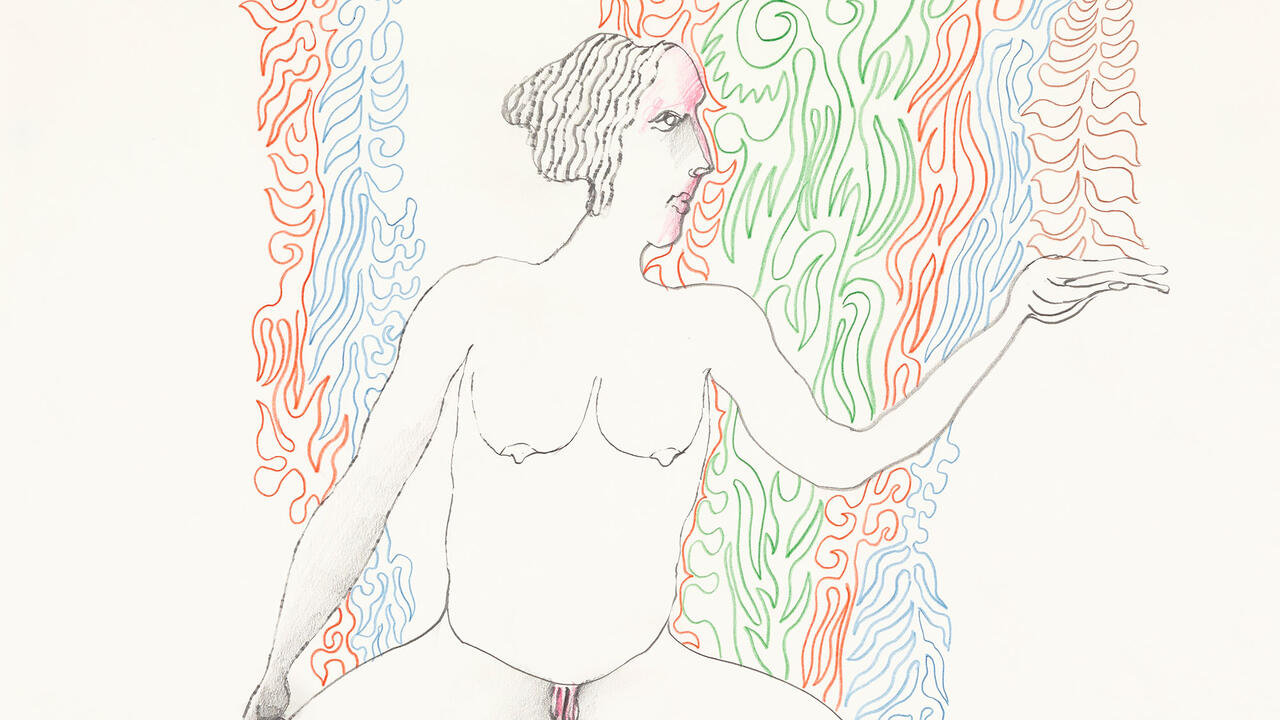Karolina Jabłońska Plays Hide and Seek
At Esther Schipper, Berlin, the artist’s self-portraits display a tension between concealment and revelation
At Esther Schipper, Berlin, the artist’s self-portraits display a tension between concealment and revelation

Sometimes, it’s remarkably hard to do what we want. In the case of Polish artist Karolina Jabłońska, being imperceptible is, ultimately, impossible. The figurative oil paintings in her first solo exhibition at Esther Schipper, ‘How to be invisible’ (all works 2023), suggest motifs for the task: wandering through a misty forest, clambering into a fridge or burying yourself beneath mountainous piles of leaves. Yet, remaining unseen is ostensibly not what these paintings really want.
In fact, as self-portraits, these canvases entrench the image of an ever-present artist. Take, for example, The Crowd, which depicts nine faces with analogous features filling the surface plane. The tightly packed assembly layers almond-shaped eyes ringed with violet circles, whiplash wisps of hair and thick eyebrows delineated with exquisitely fine brushstrokes. Jabłońska multiplies herself, repetition compounding rather than dissipating her existence. The will to escape, even existentially from oneself, is ridiculed: wherever you go, there you are.

Absurdism characterizes a tension between concealment and revealment in Jabłońska’s paintings; body parts bulkily betray themselves. In the titular canvas, How to be invisible, disproportionately huge pink feet protrude from a figure hiding inside her own T-shirt. She lays awkwardly upon yellowing grass, which illuminates her despite a stormy, cloud-filled sky. These bodies are inconveniently though gloriously immutable.
Rendered with a certain caricature – features are exaggerated, people are placed in bizarre scenarios – Jabłońska’s works call to mind those of Maria Lassnig. Self-Portrait under Plastic (1972), in which Lassnig’s piercing blue eyes stare forlornly as she suffocates under shiny polythene, was surely a direct reference for Jabłońska’s Frozen head (2022), her blue-hued face eerily encased in a colossal ice cube – which, though not part of this exhibition, was a standout work at Schipper’s 2023 group show, ‘Reconciling Apparent Contradictions’.

Jabłońska also uses symbols that clearly emerge from the lexicon of Philip Guston. The cumbersome gravitas with which he drew hands and shoes, as well as watches marking time, are taken up by Jabłońska – albeit in works that also speak to right-wing extremism but evoke a very different milieu. Jabłońska cites an interest in the ‘existential threat to [women’s] bodies and restrictions imposed by political realities’ in the show’s press materials. Her figures – which instinctively seem to want to hide, to escape – speak directly to the injustices of Poland’s far-right Law and Justice party which, during its eight years in power, banned almost all abortions: legislature that is yet to change despite the new government drafting reversal bills.
The objecthood of the body and its subordination to ideology has long concerned Poland’s women artists, particularly during the Communist regime, and Jabłońska emerges from this tradition. Antecedents range from Magdalena Abakanowicz’s woven ‘Abakans’ of the late 1960s and 1970s – swollen, vulva-esque sculptures that engulf rooms while also cocooning visitors – to spatial notions of escape in Barbara Kozłowska’s conceptual performance Borderline (1967–90), drawing a line across the globe from east to west where land meets sea during a time when freedom of movement was limited. Jabłońska continues such subversiveness: ontologically, her women cannot be confined.

While the exhibition’s tour de force is Red preserves, a towering tryptic portraying Jabłońska’s severed head pickled and domesticated in jewel-like pink liquid alongside other foodstuffs, it is the rhythmic placement of small-scale, wood-panel paintings that makes this show sing: tiny, sensory impressions offsetting the enormity of the other canvases. Head in the grass depicts a face merging with the earth, hair doubling as soil, an open mouth wantonly receiving raindrops, water trickling down a fuchsia tongue. She is part of the land and, no matter how low she lies, it is not in subjugation but in wait: inextricable, eager and with teeth like a beartrap.
Karolina Jabłońska's ‘How to be invisible’ is on view at Esther Schipper, Berlin, until 7 March
Main image: Karolina Jabłońska, The crowd, 2023, oil on canvas, 2.5 × 1.9 m. Courtesy: the artist and Esther Schipper, Berlin/Paris/Seoul; photograph: © Szymon Sokołowski



















